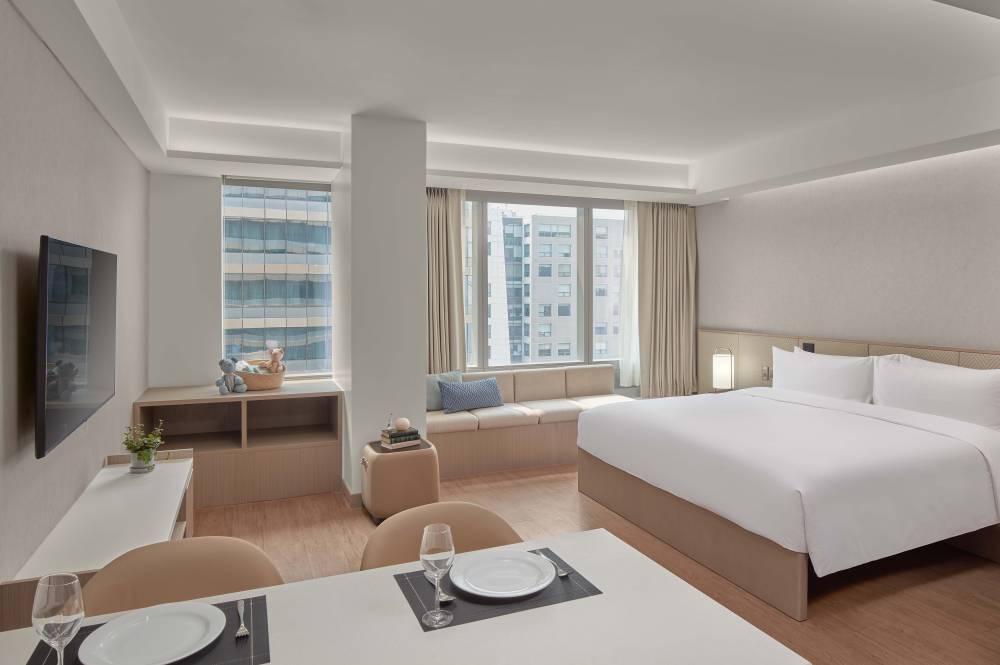Every day before it opens, MOA complex belongs to fitness buffs

From dawn until 8 a.m. on weekdays, the sprawling Mall of Asia (Moa) complex sheds its usual bustle and becomes a car-free sanctuary for runners, walkers, and cyclists. Groups pedal together for camaraderie or endurance, while joggers loop the boulevards.
Along the seawall, children with nannies, elderly residents with walkers, and friends stroll past a growing reclamation site. Nearby, volleyball players spike balls on sandy courts. Come weekends, Moa transforms into a competitive arena, hosting legions of runners in marathons, half-marathons, and fun runs.
Each morning, clusters of fitness enthusiasts pause at a refreshment stand near Lanson Place, a serviced residence and hotel within the complex. Over Americanos and sandwiches, they watch cyclists pass by.

“What I really like about our location,” said Nils Rothbarth, general manager of Lanson Place Mall of Asia Manila, “is how the day begins here with running and cycling. Even if I’m not out on the road, I join in spirit from the gym. It’s a very active community.”
He cited the appeal of the closed roads free of carbon emissions from cars: “Athletes and enthusiasts start their day together. Moa hosts a variety of runs—from serious marathons to casual fun runs—so it’s for everyone.”
Early breakfast buffet
The hotel accommodates many marathon participants and their families, opening its breakfast buffet as early as 5:30 a.m.
Since its 2023 debut, the 390-room Lanson Place has quietly emerged as a lifestyle destination. The Manila property, part of a Hong Kong-based brand, is unique for its pillar-free ballroom and wide selection of dining outlets, serving both hotel guests and long-term serviced residence tenants.
Rooms are designed with simplicity and function in mind. Rothbarth explained, “Hotel guests usually spend most of their day outside—at the mall, the pool, or exploring—so their rooms are minimalist and clutter-free.”

In contrast, serviced residences cater to longer stays, with spacious lounges, dining areas, ample storage, and fully equipped kitchens. “Some guests stay six weeks or more; a few even up to a year.”
Lanson Place is pursuing Green Key certification, an international eco-label awarded to hospitality businesses meeting strict environmental standards. Central to this effort is the property’s sustainable approach to food service and waste reduction.
The hotel’s restaurant, Cyan, offers a compact buffet blending international dishes with popular Indian cuisine, prepared by Filipino chefs trained in these culinary traditions. Catering to a multicultural clientele, the culinary team strikes a balance between healthy options and hearty comfort food.

Minimized waste
Most dishes are prepared live at cooking stations, ensuring freshness and limiting waste. Smaller batch cooking boosts quality and minimizes leftovers. While a larger kitchen handles some prep work, the focus is on made-to-order meals.
The culinary staff measures food waste daily, tracking grams per guest served. Rising waste levels prompt adjustments in menu planning. Buffets and events, known for generating leftovers, receive particular scrutiny. Soon, signage will remind diners to take only what they can finish—though second helpings are encouraged.
Food scraps are creatively repurposed whenever possible. Lemon peels, for instance, might be fermented, infused into cocktails, or reused in dishes. Waste that can’t be reused is separated and sent to farms for composting.
Sustainability is likewise embedded in the hotel’s operations. A smart energy management system adjusts temperatures based on occupancy and climate, reducing environmental impact.
“The hotel has smart rooms that switch off air conditioning and lights when guests leave,” Rothbarth explained. “Unlike older systems that rely on keycards—which could be bypassed—our sensors detect occupancy and adjust accordingly.”
The system precools rooms before arrival so guests don’t walk into humid spaces. Once a room is vacant, sensors monitor temperature and movement to optimize energy use in real time.

Intelligent climate control
This intelligent climate control extends to public spaces. Air conditioning in restaurants and function rooms adapts to the number of occupants, balancing comfort and efficiency. “We’re not trying to overcool spaces,” Rothbarth said, “just use energy wisely.”
As a new construction, Lanson Place incorporates state-of-the-art energy-saving features. Insulated walls, heat-resistant roofing, and specially glazed windows all reduce heat gain, minimizing the need for air conditioning.
“It starts with the building envelope,” Rothbarth said. “By keeping heat out, we lower energy consumption from day one.”
Daily measurement underpins all sustainability efforts. “You can’t reduce what you don’t measure,” he said. Electricity, water, and waste data help identify inefficiencies and guide improvements.
Water-saving measures include flow restrictors in guest rooms and back-of-house areas, as well as electronic flush systems that limit consumption. Most rooms feature showers, which guests prefer over bathtubs.

Feedback on these initiatives has been positive. “Many guests say we should promote our sustainability efforts more,” Rothbarth noted. “We’ve learned that part of going green is communicating it clearly.”
At its core, Lanson Place aims to deliver a lifestyle experience rooted in the long-stay market. The location adds to the appeal. Guests start their day with outdoor activities by the bay, then explore the mall’s wide range of offerings—from shopping and dining to entertainment.
“It’s a diverse environment,” Rothbarth said. “You can be as active or relaxed as you want, then return to your private, quiet space.”
He attributed repeat visits not just to amenities, but to the people. “The soul of the hotel isn’t in the décor—it’s in the team. When you’re away from home for weeks or months, those relationships matter.”
At the time of the interview, the hotelier was preparing for a vacation in Germany, where he planned to explore scenic cycling routes with his wife—drawn to the idea by the daily cyclists he admired at Moa.

















